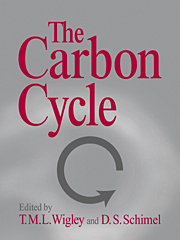Book contents
- Frontmatter
- Contents
- Preface
- Acknowledgments
- Contributors to the 1993 Global Change Institute
- I INTRODUCTION
- II THE MISSING CARBON SINK
- 3 Carbon Dioxide Emissions from Fossil Fuel Consumption and Cement Manufacture, 1751–1991, and an Estimate of Their Isotopic Composition and Latitudinal Distribution
- 4 Emissions of Carbon from Land-Use Change
- 5 The CO2 Fertilizing Effect: Relevance to the Global Carbon Cycle
- 6 Soils and the Global Carbon Cycle
- 7 Grasslands and the Global Carbon Cycle: Modeling the Effects of Climate Change
- 8 Constraints on the Atmospheric Carbon Budget from Spatial Distributions of CO2
- 9 Estimating Air–Sea Exchanges of CO2 from pCO2 Gradients: Assessment of Uncertainties
- 10 Atmospheric Oxygen Measurements and the Carbon Cycle
- 11 A Strategy for Estimating the Potential Soil Carbon Storage Due to CO2 Fertilization
- III PALEO-CO2 VARIATIONS
- IV MODELING CO2 CHANGES
- Part V Appendixes
- Index
9 - Estimating Air–Sea Exchanges of CO2 from pCO2 Gradients: Assessment of Uncertainties
from II - THE MISSING CARBON SINK
Published online by Cambridge University Press: 04 December 2009
- Frontmatter
- Contents
- Preface
- Acknowledgments
- Contributors to the 1993 Global Change Institute
- I INTRODUCTION
- II THE MISSING CARBON SINK
- 3 Carbon Dioxide Emissions from Fossil Fuel Consumption and Cement Manufacture, 1751–1991, and an Estimate of Their Isotopic Composition and Latitudinal Distribution
- 4 Emissions of Carbon from Land-Use Change
- 5 The CO2 Fertilizing Effect: Relevance to the Global Carbon Cycle
- 6 Soils and the Global Carbon Cycle
- 7 Grasslands and the Global Carbon Cycle: Modeling the Effects of Climate Change
- 8 Constraints on the Atmospheric Carbon Budget from Spatial Distributions of CO2
- 9 Estimating Air–Sea Exchanges of CO2 from pCO2 Gradients: Assessment of Uncertainties
- 10 Atmospheric Oxygen Measurements and the Carbon Cycle
- 11 A Strategy for Estimating the Potential Soil Carbon Storage Due to CO2 Fertilization
- III PALEO-CO2 VARIATIONS
- IV MODELING CO2 CHANGES
- Part V Appendixes
- Index
Summary
Abstract
The gradients in partial pressure of CO2 across the air–sea interface provide a starting point for estimating regional and global CO2 fluxes between the atmosphere and ocean. They also are critical constraints on global atmospheric and oceanic models used to infer the land–sea partitioning of CO2 uptake. Here, we assess the factors that contribute to uncertainties in the estimated CO2 fluxes.
We estimate measurement precision in pCO2 to be ±2 μatm, and extrapolation of the data to regions with no measurements yields uncertainties of ±0.8 μatm. The short duration of spring blooms in the North Atlantic diminishes the uncertainties arising from sparse seasonal coverage in the measurements. We estimate an oceanic uptake of 0.3 Gt C/yr due to spring blooms in the North Atlantic. It is difficult to quantify the extent to which pCO2 gradients may change by correcting the pCO2 measurements to skin instead of bulk temperatures, as skin–bulk temperature differences may be positive (negative) with strong surface heating (cooling), or may vanish under high wind conditions. Uncertainties in fluxes associated with gas exchange rates cannot be separated from the yet unknown flux contributions from the covariance between high-frequency wind and pCO2 fluctuations.
In addition to expanded spatial coverage, high-resolution and high-frequency sampling of the meteorology, hydrography, and carbon system in the atmospheric and oceanic boundary layers at a few locations is needed for improving estimates of air-sea CO2 fluxes.
- Type
- Chapter
- Information
- The Carbon Cycle , pp. 125 - 133Publisher: Cambridge University PressPrint publication year: 2000
- 3
- Cited by



